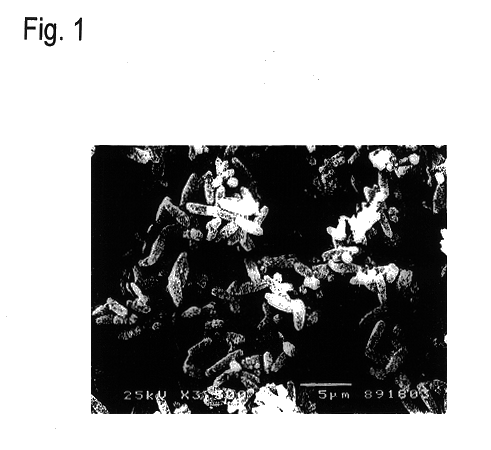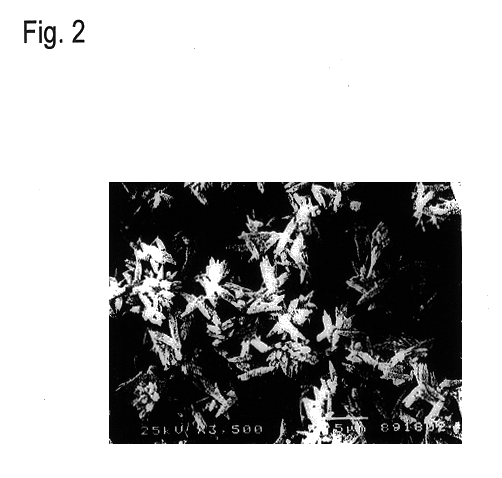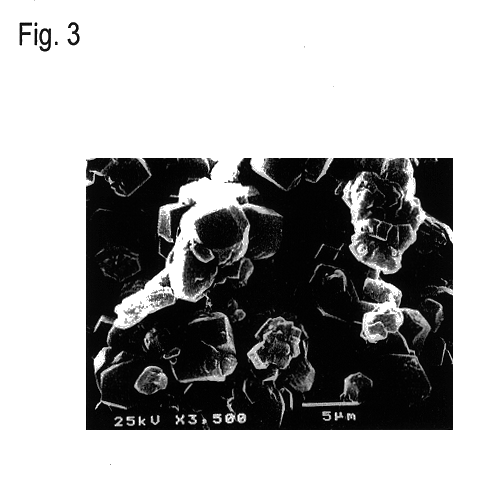Process for preparing calcium carbonate
a technology of calcium carbonate and process, applied in the field of process for preparing calcium carbonate, can solve the problems of difficult shape control, severe ablation of plastic wires, insufficient bulk, etc., to achieve the effect of improving opacity and brightness, improving plastic wire abrasion resistance during high-speed paper making, and improving yield
- Summary
- Abstract
- Description
- Claims
- Application Information
AI Technical Summary
Benefits of technology
Problems solved by technology
Method used
Image
Examples
example 1
In a IL four-necked flask (also used in the following examples and comparative examples), 50 g of a quick lime having a calcium carbonate content of 1.6% (and having a particle size distribution of 4.0% 150 .mu.m or more, 18.1% 150-75 .mu.m, 19.4% 75-45 .mu.m, 58.5% 45 .mu.m or less) was mixed with a white liquor (composition: Na.sub.2 CO.sub.3 =24 g / L, Na.sub.2 S=31 g / L, NaOH=71 g / L, all expressed as Na.sub.2 O in the same way as in the following examples and comparative examples) at a quick lime concentration of 7% by weight and then slaked to prepare a milk of lime, which was then causticized with a green liquor (composition: Na.sub.2 CO.sub.3 =110 g / L, Na.sub.2 S=34 g / L, NaOH=6 g / L, all expressed as Na.sub.2 O in the same way as in the following examples and comparative examples) under the conditions of a green liquor loading rate of 0.22 cc / min / g (quick lime), loading period of 60 min, temperature of 80.degree. C. and agitation speed of 450 rpm (using POWER STAIRRER TYPE PS-2N ...
example 2
Using 50 g of a quick lime having a calcium carbonate content of 3.0% (and having a particle size distribution of 4.4% 150 .mu.m or more, 17.4% 150-75 .mu.m, 20.1% 75-45 .mu.m, 58.1% 45 .mu.m or less) and the same white liquor as used in Example 1, the quick lime was mixed with the white liquor at a quick lime concentration of 14% by weight and then slaked to prepare a milk of lime, which was then causticized with the same green liquor as used in Example 1 under the conditions of a green liquor loading rate of 0.5 cc / min / g (quick lime), loading period of 30 min, temperature of 85.degree. C. and agitation speed of 1000 rpm. The product was found to be rice-like calcium carbonate having an average particle diameter of 3.6 .mu.m, an average maximum diameter of 3.6 .mu.m and an average minimum diameter of 1.0 .mu.m. Experimental conditions and results are shown in Table 1.
example 3
50 g of a kiln-recalcinated quick lime having a calcium carbonate content of 7% (and having an average particle diameter 10 mm) was mixed with the same white liquor as used in Example 1 at a quick lime concentration of 30% by weight and then slaked to prepare a milk of lime, which was then causticized with the same green liquor as used in Example 1 under the conditions of a loading rate of 28 cc / min / g (quick lime), loading period of 0.5 min, temperature of 95.degree. C. and agitation speed of 600 rpm. The product was found to be rice-like calcium carbonate having an average particle diameter of 4.0 .mu.m, an average maximum diameter of 4.0 .mu.m and an average minimum diameter of 1.1 .mu.m. Experimental conditions and results are shown in Table 1.
PUM
| Property | Measurement | Unit |
|---|---|---|
| temperature | aaaaa | aaaaa |
| length | aaaaa | aaaaa |
| width | aaaaa | aaaaa |
Abstract
Description
Claims
Application Information
 Login to View More
Login to View More - R&D
- Intellectual Property
- Life Sciences
- Materials
- Tech Scout
- Unparalleled Data Quality
- Higher Quality Content
- 60% Fewer Hallucinations
Browse by: Latest US Patents, China's latest patents, Technical Efficacy Thesaurus, Application Domain, Technology Topic, Popular Technical Reports.
© 2025 PatSnap. All rights reserved.Legal|Privacy policy|Modern Slavery Act Transparency Statement|Sitemap|About US| Contact US: help@patsnap.com



